As a business owner, you need to write a termination letter sometimes. This type of letter is used to fire bad employees. You may a little bit confused about how to write down a letter. Actually, a termination letter template can help you to create a perfect termination letter. So, what you have to fill in a termination letter template?
What should be included in a termination letter?
Some Important Points in Termination Letter Template:
Your Company Name and Date
The “Your Company Name and Date” section is typically the header of the termination letter, and it serves several important functions:
- Identification: Including the company name identifies who the letter is from. It is particularly important if the company has multiple divisions or subsidiaries. The employee should be able to recognize the sender of the letter immediately.
- Authenticity: The company name adds a level of authenticity to the letter. It shows that the letter is an official document from the company, not a personal letter from a manager or coworker.
- Date: The date is crucial as it provides a timeline for the termination process. It indicates when the decision was communicated to the employee. It can be important for determining when certain obligations or benefits start or end, such as the final paycheck, continuation of health insurance, or eligibility for unemployment benefits.
- Record Keeping: Both the company name and date are important for record keeping. If there are any disputes or legal proceedings in the future, the letter serves as a formal record of when the company communicated the termination decision to the employee.
When writing the company name and date, it’s important to use the full, official company name and the complete date (including day, month, and year). This section is typically placed at the top of the letter, either centered or aligned to the left.
Reason to Terminate the Employee
It provides the employee with a clear understanding of why their employment is being ended. This section should be written carefully, as it can have legal implications. Here are some elements that might be included in this section:
- Performance Issues: If the job termination is due to poor performance, the letter should specify the performance issues that led to this decision. It’s important to refer to any previous warnings or performance improvement plans the employee gave.
- Misconduct: If the employee is being terminated due to misconduct, the letter should clearly describe the misconduct and refer to the violated company policies.
- Redundancy: If the termination is due to redundancy (i.e., the job position is no longer needed), the Redundancy letter should explain this. It should also mention any efforts to find the employee in a different position within the company, if applicable.
- Failure to Meet Job Requirements: If the employee is being terminated because they cannot meet their Job requirements, the letter should detail these requirements and how they failed to meet them.
- Business Downturn or Closure: If the business is closing or downsizing, this should be clearly stated in the letter.
- Violation of Company Policies: If the termination is due to a violation of company policies, the letter should specify which policy or policies were violated.
The reason for termination should be factual, clear, and concise. It’s important to avoid personal criticisms or subjective statements. The reason should be defensible in case of any legal challenge. It’s always a good idea to consult with a Human Resources professional or legal counsel when drafting a termination letter to ensure it is legally sound and respectful.
The Requirements
Besides writing down about the reason, the termination letter sample also guides you to write down anything that the employee has to return. Sometimes, the point is in the form of a list so you can easily write all they need to return. You can write specific things such as the car, credit card, uniform, and badge. Later, the employee can prepare all of them while reading the letter.
“The Requirements” section in a termination letter typically refers to the obligations or actions the terminated employee must fulfill following their termination. It often involves the return of company property. Here are some elements that might be included in this section:
- Company Property: Employees may have company property such as laptops, mobile phones, keys, security cards, or other equipment. The termination letter should list these items and provide instructions on how and when they should be returned.
- Company Documents: The employee might have access to important company documents or data. The letter should instruct the employee to return or delete these documents if they are in digital format, per the company’s data retention policy.
- Confidentiality and Non-Disclosure: The termination letter should remind the employee of their obligations under any confidentiality or non-disclosure agreements they signed during their employment. It could include not sharing trade secrets, client lists, or other sensitive information.
- Non-Compete Clauses: If the employee’s contract included a non-compete clause, the termination letter should remind them of this and provide details about what this means in practical terms, such as restrictions on working for competitors within a certain time frame.
- Final Paycheck and Benefits Information: The letter should inform when and how the employee will receive their final paycheck. It should also detail any accrued vacation pay, severance pay, or continuation of benefits, if applicable.
- Exit Interview: Some companies conduct exit interviews with departing employees. If this is the case, the letter should specify when and how this will occur.
Requirements section of a termination letter can vary based on the company’s policies, the employee’s contract, and local employment laws. It’s always a good idea to consult with a Human Resources professional or legal counsel when drafting a termination letter to ensure all necessary information is included and the letter complies with all relevant laws and regulations.
The Benefits
Don’t forget to write down the benefits they can get until the end of the termination period. In this case, you can also include the things that they don’t get after the termination period. If you download a termination letter template, you will see a space to write down this kind of information.
In the context of a termination letter, “The Termination benefits” refers to the specific perks or advantages an employee is entitled to receive until the end of their termination period and potentially beyond.
This section of the termination letter is crucial as it clarifies to employees what they can expect regarding benefits during and after their termination period.
Here are some elements that might be included in this section:
- Severance Pay: If the company offers severance pay, the letter should clearly state this. The amount, how it will be paid (lump sum or installments), and when it will be paid should be specified.
- Continuation of Health Benefits: Under laws in some countries, such as the United States COBRA law, employees may be eligible to continue their health insurance coverage for a certain period after termination. If this applies, the letter should detail how the employee can opt into this coverage and any associated costs.
- Pension or Retirement Benefits: If the employee has a pension plan or other retirement benefits, the letter should explain what will happen to these benefits. This could include information on how and when they can access these funds.
- Unused Vacation or Sick Leave: If the company’s policy or local law allows for payment of unused vacation or sick leave, this should be mentioned in the letter. The amount of leave to be paid and when this will occur should be specified.
- Outplacement Services: Some companies offer outplacement services to help terminated employees find new jobs. The letter should provide details about accessing these services if this is offered.
- Return of Personal Items: If the employee has personal items at the workplace, the letter should explain how they can retrieve them.
Remember, what to include in a termination letter’s “Benefits” section can vary based on the company’s policies, the employee’s contract, and local employment laws. It’s always a good idea to consult with a Human Resources professional or legal counsel when drafting a termination letter to ensure all necessary information is included and the letter complies with all relevant laws and regulations.
Signature
When you are done completing the detail, you have to do the last action. You have to give a signature on the letter. Your signature is very important to make sure that the letter is a legal letter. Without your signature, the letter is only an ordinary letter without any power to terminate an employee. The function of the termination letter template is to help you to sign the letter in the right place. The template has been set with the place to put a signature so you can use the letter right away after signing it.
What should not be included in a termination letter?
Certain things should be excluded from this letter. Here are some of them:
- Personal Criticisms or Insults: A termination letter should remain professional and respectful. Avoid including personal criticisms, insults, or derogatory comments about the employee. Stick to the facts related to the employee’s performance or behavior that led to the termination.
- Subjective Opinions or Unsubstantiated Claims: The reasons for termination should be factual and defensible. Avoid including subjective opinions or claims that cannot be substantiated. It can help protect the company in case of a legal dispute.
- Irrelevant Personal Information: Avoid including personal information about the employee irrelevant to the termination. It could include details about the employee’s personal life, health, or other private matters.
- Promises or Assurances: Be careful to refrain from including any promises or assurances that the company may not be able to fulfill. It could include promises of future employment, references, or benefits that are not guaranteed.
- Legal Jargon: While the termination letter needs to be legally sound, avoid using excessive legal jargon that the employee may need help understanding. The letter should be clear and easy to understand.
It should avoid personal criticisms, subjective opinions, irrelevant personal information, unfulfillable promises, and excessive legal jargon. Always consult a Human Resources professional or legal counsel when drafting a termination letter to ensure it is legally sound and respectful.
What is the minimum notice period for termination of employment?
The length of the notice period can vary greatly depending on several factors:
- Employment Contract: It may specify a notice period. It is often true for salaried employees, especially in management or professional roles.
- Company Policy: Some companies have policies that dictate the notice period. These policies may vary based on the employee’s role, length of service, or other factors.
- Local Laws: In many places, labor laws or employment standards legislation set minimum notice periods. These laws often require longer notice periods for employees with the company longer.
- Collective Bargaining Agreements: The notice time may be set out in a collective bargaining contract for unionized workers.
It’s important to note that in some cases, an employee may be “paid in lieu of notice” instead of working through the notice period. It means the employee receives a payment equal to what they would have earned during the notice period, but their employment ends immediately.
In some situations, such as gross misconduct, immediate dismissal without notice of termination may be justified. Still, these situations are relatively rare and should be handled carefully to avoid potential legal issues.
As always, when dealing with termination of employment, it’s a good idea to consult with a Human Resources professional or legal counsel to ensure compliance with all relevant laws and regulations.
Termination Letter Template
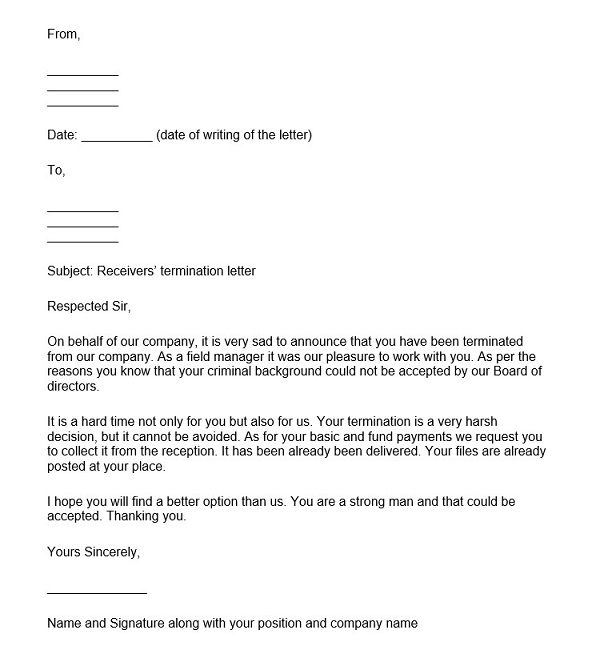
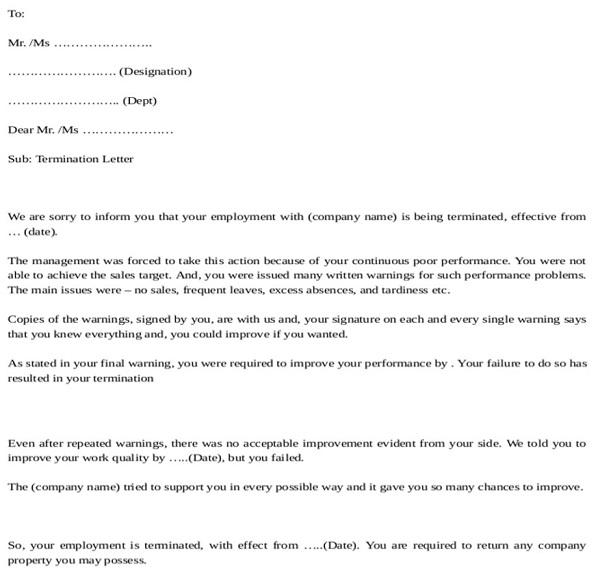
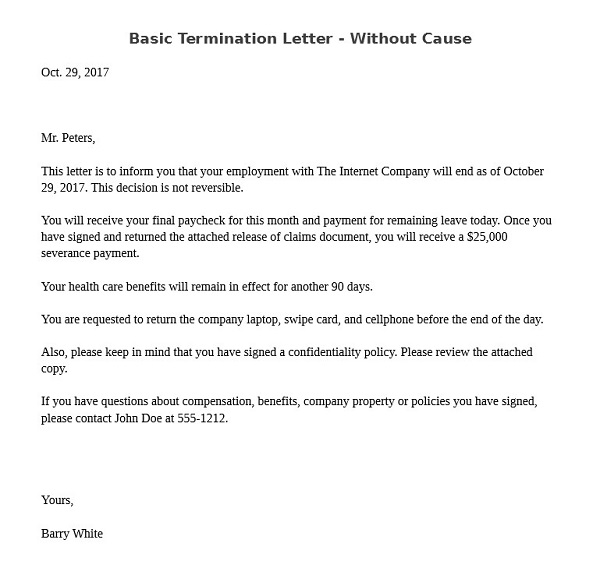
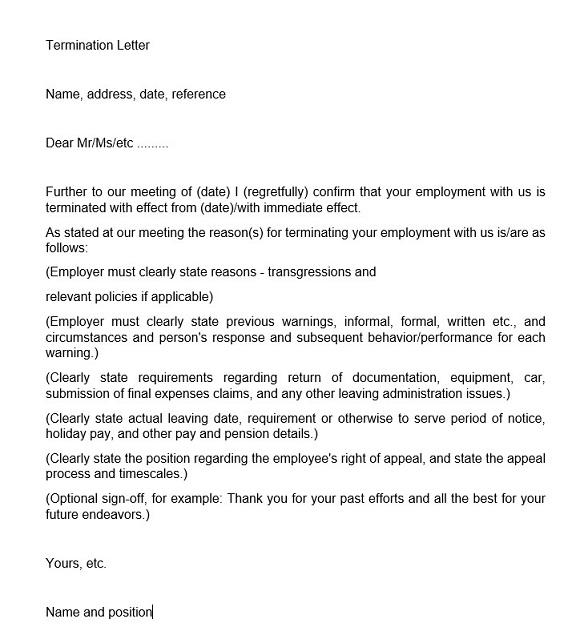
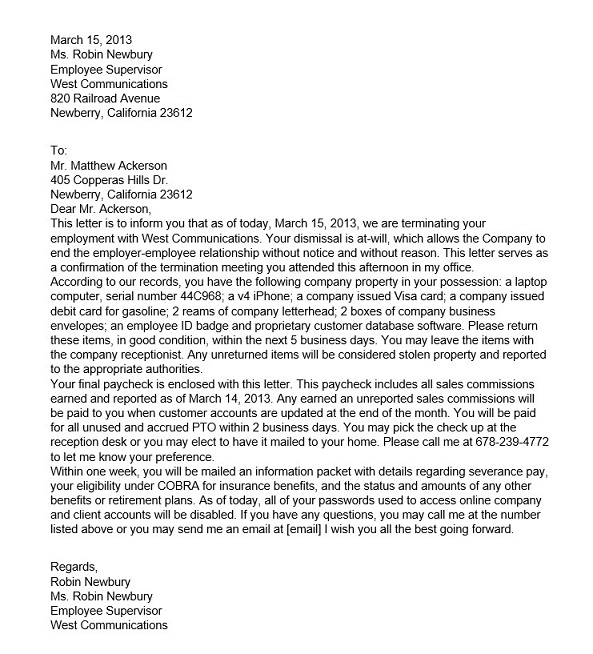
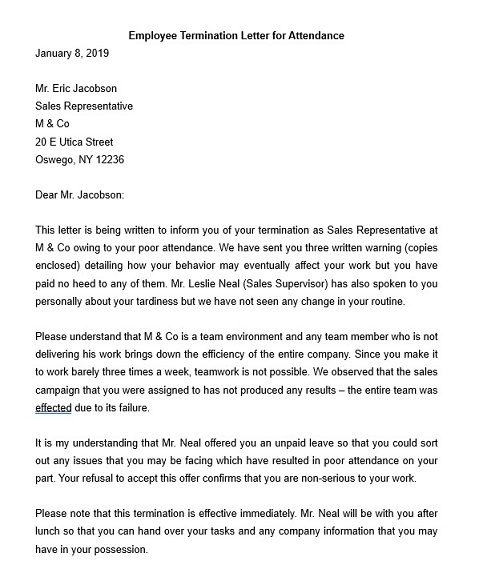
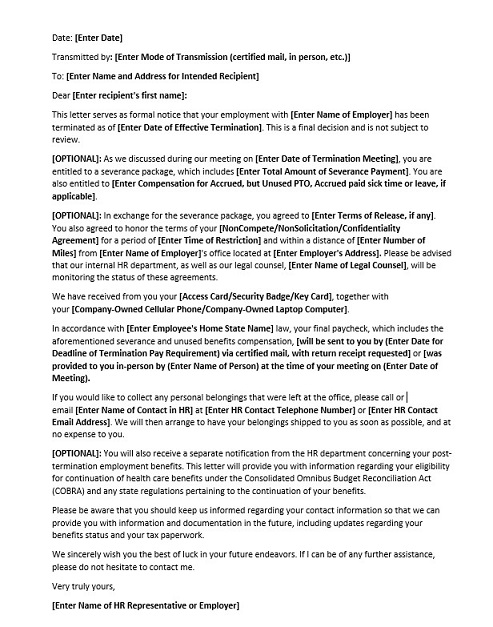
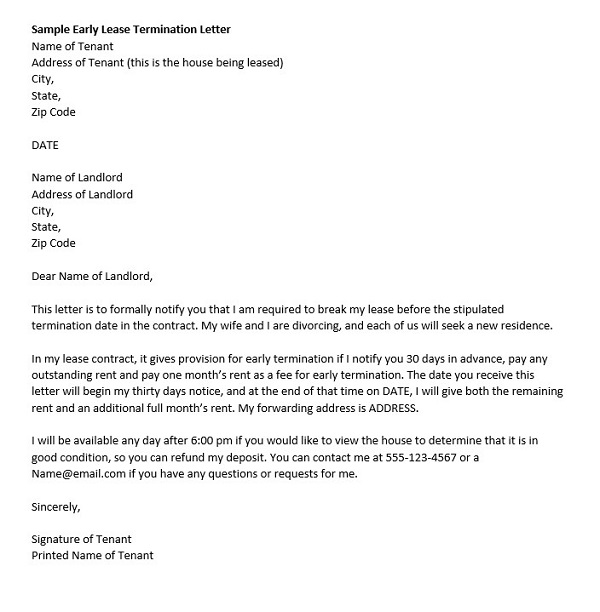
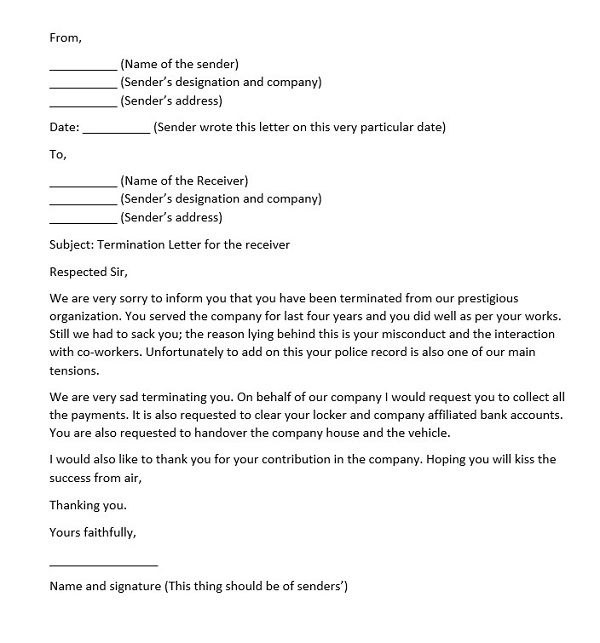
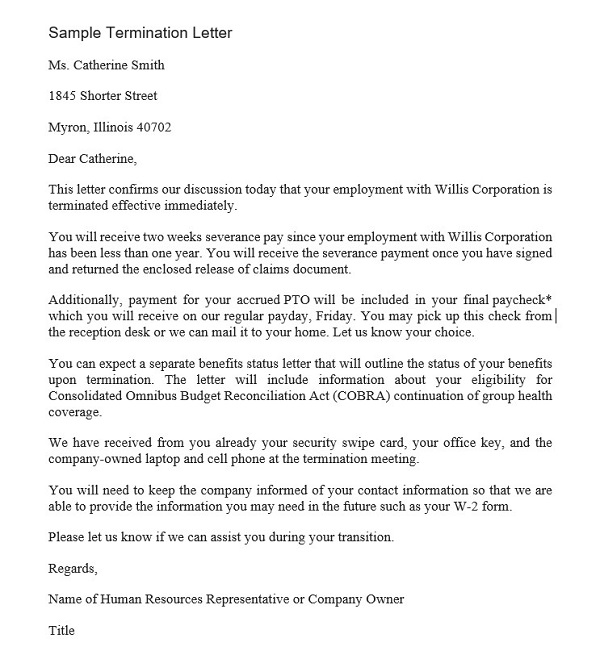
What is the difference between termination “with cause” and “without cause”?
In the context of employment termination, the terms “with cause” and “without cause” refer to the reasons for the termination.
- Termination “With Cause”: Refers to situations where the employee is being let go due to specific reasons related to their performance or behavior. These reasons could include poor job performance, violation of company policies, misconduct, insubordination, or other detrimental actions to the company or its employees. In such cases, the employer has a specific reason, or “cause,” for ending the employment relationship. The employer should be able to provide evidence or documentation of the issues that led to the termination if needed.
- Termination “Without Cause”: Refers to situations where the employee is being let go for reasons unrelated to their performance or behavior. These reasons could include business downturn, restructuring, position elimination, or other business operational needs. In these cases, the termination is not due to the employee’s fault, hence the term “without cause.”
It’s important to note that the implications of a “with cause” versus “without cause” termination can vary based on local laws and company policies. For example, in some jurisdictions, employees terminated “without cause” may be entitled to severance pay or additional notice, while those terminated “with cause” may not.
Why is a termination letter important?
A termination letter serves several crucial functions in ending an employment relationship, making it an important document for employers and employees. Here are some reasons why a termination letter is important:
- Record of Termination: A termination letter provides a formal, written record of the decision to end the employment relationship. It can be important for both parties in future disputes or misunderstandings about the termination.
- Clear Communication: The termination letter communicates the reasons for the termination to the employee. It can help the employee understand why they are being let go and can also provide closure.
- Legal Protection: If the termination is contested or leads to legal action, the dismissal letter can be a key piece of evidence. It can demonstrate that the employer had a valid reason for the termination and that the employee was informed clearly and promptly.
- Guidance for Next Steps: The termination letter can guide the employee about what to expect next, such as a final paycheck, benefits information, and requirements for returning company property. It can help ensure a smooth transition for the employee and the employer.
- Professionalism: Issuing a termination letter demonstrates professionalism on the part of the employer. It shows that the employer handles the termination seriously and respectfully, which can be important for maintaining the company’s reputation.
A termination letter is a critical tool in ending an employment relationship. It provides clarity, offers legal protection, guides the next steps, and demonstrates professionalism.
In conclusion
Understanding a termination letter’s nuances is crucial for employers and employees. This document serves as a formal, written record of the termination of employment, providing clarity and legal protection for all parties involved.
It should include key elements such as the company’s name and date, the reason for termination, any requirements from the employee, the benefits the employee will receive, and a signature from an authorized company representative. Each element ensures the letter is comprehensive, clear, and legally sound.
However, it’s equally important to know what should not be included in a termination letter, such as personal criticisms, subjective opinions, irrelevant personal information, unfulfillable promises, and excessive legal jargon.
The importance of a termination letter cannot be overstated. It provides a record of termination, clear communication, legal protection, guidance for the next steps, and demonstrates professionalism.
Understanding the difference between termination “with cause” and “without cause” is also crucial, as it can have significant implications for both the employer and the employee.
As always, consulting with a Human Resources professional or legal counsel is recommended when dealing with terminations to ensure compliance with all relevant laws and regulations.

The content creator team at calipsotree.com is dedicated to making topics accessible to everyone, with over 9 years of experience in writing and breaking down complex concepts into easy-to-understand articles that answer readers’ financial questions.








